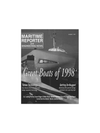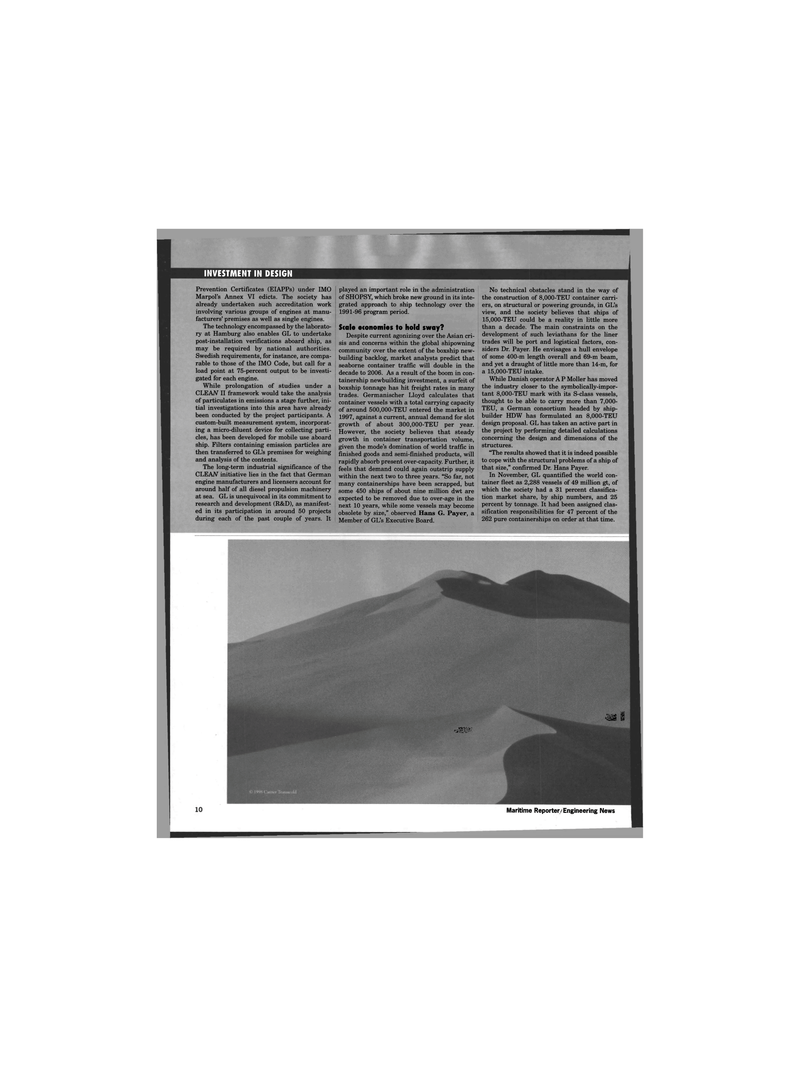
Page 10: of Maritime Reporter Magazine (January 1999)
Read this page in Pdf, Flash or Html5 edition of January 1999 Maritime Reporter Magazine
INVESTMENT IN DESIGN
Prevention Certificates (EIAPPs) under IMO
Marpol's Annex VI edicts. The society has already undertaken such accreditation work involving various groups of engines at manu- facturers' premises as well as single engines.
The technology encompassed by the laborato- ry at Hamburg also enables GL to undertake post-installation verifications aboard ship, as may be required by national authorities.
Swedish requirements, for instance, are compa- rable to those of the IMO Code, but call for a load point at 75-percent output to be investi- gated for each engine.
While prolongation of studies under a
CLEAN II framework would take the analysis of particulates in emissions a stage further, ini- tial investigations into this area have already been conducted by the project participants. A custom-built measurement system, incorporat- ing a micro-diluent device for collecting parti- cles, has been developed for mobile use aboard ship. Filters containing emission particles are then transferred to GL's premises for weighing and analysis of the contents.
The long-term industrial significance of the
CLEAN initiative lies in the fact that German engine manufacturers and licensers account for around half of all diesel propulsion machinery at sea. GL is unequivocal in its commitment to research and development (R&D), as manifest- ed in its participation in around 50 projects during each of the past couple of years. It played an important role in the administration of SHOPSY, which broke new ground in its inte- grated approach to ship technology over the 1991-96 program period.
Scale economies to hold sway?
Despite current agonizing over the Asian cri- sis and concerns within the global shipowning community over the extent of the boxship new- building backlog, market analysts predict that seaborne container traffic will double in the decade to 2006. As a result of the boom in con- tainership newbuilding investment, a surfeit of boxship tonnage has hit freight rates in many trades. Germanischer Lloyd calculates that container vessels with a total carrying capacity of around 500,000-TEU entered the market in 1997, against a current, annual demand for slot growth of about 300,000-TEU per year.
However, the society believes that steady growth in container transportation volume, given the mode's domination of world traffic in finished goods and semi-finished products, will rapidly absorb present over-capacity. Further, it feels that demand could again outstrip supply within the next two to three years. "So far, not many containerships have been scrapped, but some 450 ships of about nine million dwt are expected to be removed due to over-age in the next 10 years, while some vessels may become obsolete by size," observed Hans G. Payer, a
Member of GL's Executive Board.
No technical obstacles stand in the way of the construction of 8,000-TEU container carri- ers, on structural or powering grounds, in GL's view, and the society believes that ships of 15,000-TEU could be a reality in little more than a decade. The main constraints on the development of such leviathans for the liner trades will be port and logistical factors, con- siders Dr. Payer. He envisages a hull envelope of some 400-m length overall and 69-m beam, and yet a draught of little more than 14-m, for a 15,000-TEU intake.
While Danish operator A P Moller has moved the industry closer to the symbolically-impor- tant 8,000-TEU mark with its S-class vessels, thought to be able to carry more than 7,000-
TEU, a German consortium headed by ship- builder HDW has formulated an 8,000-TEU design proposal. GL has taken an active part in the project by performing detailed calculations concerning the design and dimensions of the structures. "The results showed that it is indeed possible to cope with the structural problems of a ship of that size," confirmed Dr. Hans Payer.
In November, GL quantified the world con- tainer fleet as 2,288 vessels of 49 million gt, of which the society had a 31 percent classifica- tion market share, by ship numbers, and 25 percent by tonnage. It had been assigned clas- sification responsibilities for 47 percent of the 262 pure containerships on order at that time. igpt ' ri 12
Maritime Reporter & Engineering News

 9
9

 11
11
